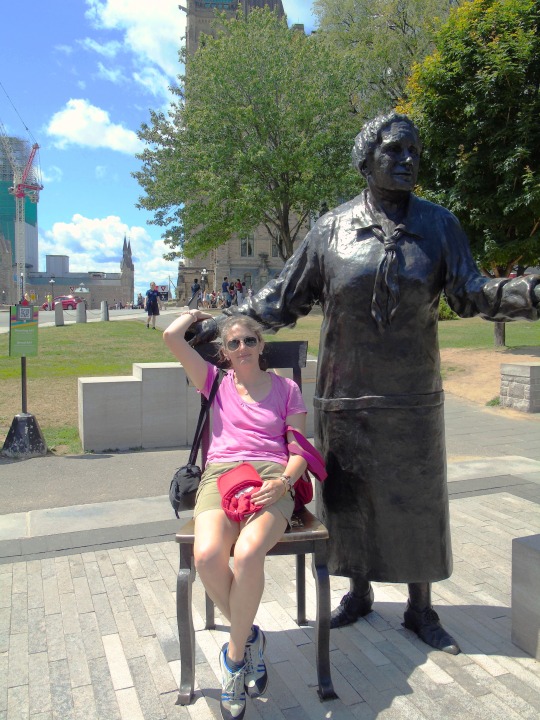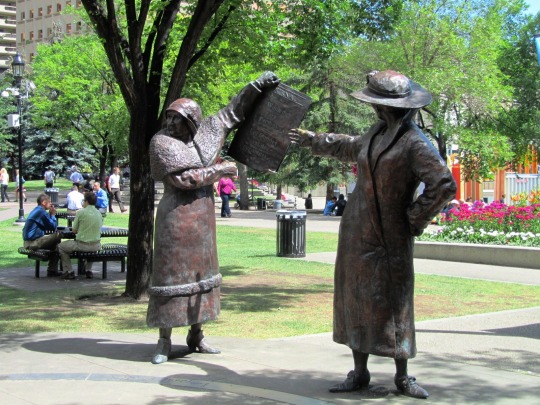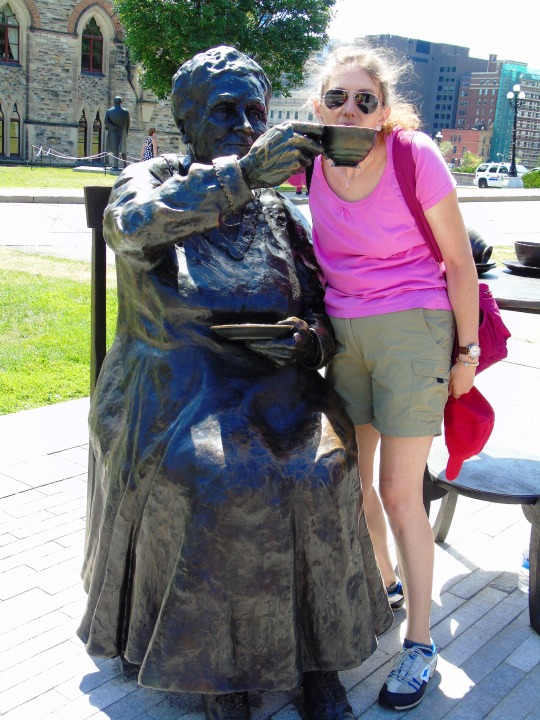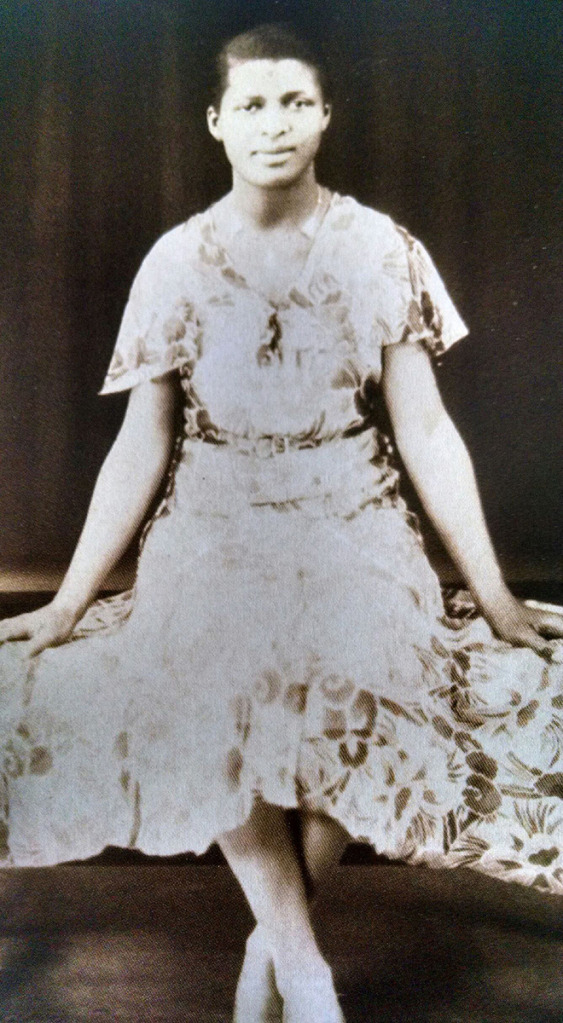#18 October 1929
Text











Persons Day
It marks the day in 1929 when the historic decision to include women in the legal definition of “persons” was handed down by Canada’s highest court of appeal. This gave some women the right to be appointed to the Senate of Canada and paved the way for women's increased participation in public and political life. Though this decision did not include all women, such as Indigenous women and women of Asian heritage and descent, it did mark critical progress in the advancement of gender equality in Canada.
The History of the Persons Case
In Canada, the British North America Act (BNA Act) of 1867 set out the powers and responsibilities of the provinces and of the federal government. The Act used the word “persons” when referring to more than one person and “he” when referring to one person. Many argued the Act implicitly stated that only a man could be a person, which prevented women from participating fully in politics or affairs of state.
Governments also used the “persons” argument to keep women out of important positions. If the word “person” applied only to men, then the stipulation that only “qualified persons” could be appointed to the Senate of Canada meant that only men could be appointed.
In 1927, five women who have since become known as the Famous Five launched a legal challenge that would mark a turning point for equality rights in Canada. Emily Murphy, Nellie McClung, Louise McKinney, Irene Parlby and Henrietta Muir Edwards were journalists, politicians, reformers and activists from Alberta who asked the Supreme Court of Canada to answer the following question: does the word “person” in Section 24 of the BNA Act include female persons? After five weeks of debate, the Supreme Court decided that the word “person” did not include women.
Although shocked by the Court’s decision, the Famous Five did not give up the fight and took their case to the Judicial Committee of the Privy Council of Great Britain in London, which was then Canada’s highest court of appeal.
On October 18, 1929, Lord Sankey, Lord Chancellor of Great Britain, announced the decision:
“The exclusion of women from all public offices is a relic of days more barbarous than ours. And to those who would ask why the word ‘person’ should include females, the obvious answer is, why should it not?”
On Persons Day, we honour the bravery and determination of the Famous Five whose landmark case helped pave the way for women to participate equally in all aspects of life in Canada. We also honour all those whose work in the years since then has expanded and strengthened those rights.
Over the years, statues of the Famous Five have been erected in Canada, such as the one depicted on this year’s image that can be found in Winnipeg near the Manitoba Legislative Building. Different statues honouring these women can also be found in Calgary and Ottawa.
Source
#Women are Persons By Barbara Patterson#Persons Day#The Persons Case#public art#Ottawa#Calgary#original photography#18 October 1929#anniversary#history#summer 2015#2012#canada#2018#cityscape#Ottawa River#Supreme Court of Canada#travel#vacation#road trip#architecture#Ontario#Alberta#Ernest Cormier#Art Deco#301 Wellington Street
1 note
·
View note
Text
My 1950s Housewife Dr





ME:
Name: [REDACTED] Robertson
Age: 17 (single) 18/19 (married)
Birthday: [redacted] 1933
Appearance:




Hobbies/Skills: painting, music (specifically piano), baking, gardening, small talk, cleaning, other “things”, writing, reading, sewing
Job: I later become a famous writer and painter.

MY HUSBAND:
Name: James Walter Robertson
Age: 20-21
Birthday: 13th of June 1929
Appearance:




Job: owns largest car company in the world (Mercedes)
Relationship:
our relationship is literally perfect, he’s super devoted to me and absolutely ADORES ME, he loves to dote on me and is just super affectionate and supportive.
we met when I was five and he was eight because he had a small holiday house next to my family home and every summer and winter he would come down to the country and hangout with me. when He was 16 and I was 13 he left permanently.
how we got together: When I was 17 he and his family visited and came over for dinner and we reconnected👹

MY DAUGHTER
Name: Ivy Rose Robertson
Age: 3
Birthday: 18th of October
Appearance:



Our relationship: we adopted her when she was two and she is such a mamas girl, she’s very soft and
quite but she loves to explore and help her mum with painting

I’ll do my house and friends in part two xx
thank you to the love of my life @kelpstheshifter for the idea xx
#shifting blog#shifting community#reality shifting#shifting#shifting antis dni#shifting diary#shifting consciousness#shifting motivation#shifting stories#shifting script#shiftblr#shifters#shiftinconsciousness#quantum jumping#reality shifter#permashifting#desired reality#how to manifest#manifesting#manifesation#manifest#loans#loa tumblr#loa#loassumption#loa blog#loablr#neville goddard#robotic affirming#living in the end
126 notes
·
View notes
Text
Dutch zoological illustrator Joseph Smit was born #OTD (18 July 1836 – 4 November 1929).

Himalayan Monal (Lophophorus impejanus) by Joseph Smit for Major C.H.T. Marshall, Plate X in I IBIS, October 1884.
Via Biodiversity Heritage Library
#animals in art#european art#birds in art#bird#Himalayan Monal#IBIS#British Ornithologists Union#19th century art#sciart#historical sciart#scientific illustration#natural history art#Joseph Smit#ornirhology#ornithological illustration#lithograph#OTD#birthday post
23 notes
·
View notes
Text
Heinrich Himmler's time line

This is Heinrich Himmler, the Head of the SS, timeline:
1900: He was born on 7th of October in Munich.
1905: His younger brother, Ernst Himmler, was born.
1913: he attended his father's school in Landshut, the town where the family had moved.
1919: From April 1919 Himmler joined various Freikorps, to "erase the shame of Versailles" and overthrow the "Marxist dictatorship". These enlistments were partly due to the guilt he had for not being able to fight in the Great War
1919: In August 1919 he was already working on a farm near Ingolstadt, but his work on the farm did not last long; On September 4 he fell ill. He had paratyphoid fever.
1919: On 18 October he was accepted as a student in agriculture at the University of Munich
1922: After completing his university studies in with a diploma in agriculture, he immediately found work at a fertilizer company, Stickstoff-Land
1923: He joined the Nazi Party in 1923, card N 156.
1923: He take part in the Failed Munich Putsch, but, while Ernst Röhm and Adolf Hitler were arrested, Himmler was considered an insignificant supporting actor and therefore did not suffer punishment.
1925: He was fired and, unemployed, decided to join Erich Ludendorff's new political formation, the National Socialist Liberation Movement.
1925: During that period he also met Gregor Strasser, of whom he soon became his personal secretary.
1925: An official of the Lower Bavarian Gau, based in Landshut, he took steps to revitalize the National Socialist sections in the area. He was promoted to vice-Gauleiter of Lower Bavaria-Upper Palatinate
1928: He married Margarete Boden
1929: He was appointed Reichsfuhrer SS by Hitler.
1929: His daughter, Gudrun Himmler, was born
1931: He commissioned Reinhard Heydrich to establish the SD.
1933: When the National Socialist Party took power in Bavaria on March 9, 1933, Himmler took control of the police.
1934: In May 1934, he had command of all police forces, with the exception of Prussia.
1934: He was one of the main organizers of the Night of the Long Knives
1934: As a reward for his role, Himmler gained control of the Gestapo, the secret political police.
1934: he gave the order to search the length and breadth of western Germany, until he found the ruins of the mountain fortress of Wewelsburg
1935: On December 10, 1935, "Lebensborn e.V." was founded in Berlin.
1936: Himmler was appointed Chef der Deutschen Polizei, or commander of the entire police, political and secret activity of the whole of Germany. In this new function, Himmler could participate in meetings of the Hitler government, since his position was equivalent to that of a minister.
1936: In the summer of 1936, he had the thousandth anniversary of the death of Henry I the Birdcatcher celebrated in Quedlinburg.
1936: Himmler issued a decree to proceed with the reorganization of the German police.
1937: At the end of the renovation works, Wewelsburg had transformed into a true shrine, with dozens of statues of Henry I the Birdcatcher, Frederick of Hohenstaufen and other German heroes.
1938: on 28 October 1938, Himmler had a note spread among all SS members, according to which it was a duty for every SS man to procreate at least four children to preserve his good blood before leaving for the front.
1939: The ''Operation Himmler'' begins the Second World War
1942: Reinhard Heydrich held the Wannsee Conference, where the so-called ''final solution'' was organized
1943: on October 4 and 6 he gave the Posen speeches.
1945: Himmler appeared for the last time at Hitler's Führerbunker in Berlin on 20 April 1945, on the occasion of the Führer's birthday
1945: A few days later, on April 23, Himmler met Count Folke Bernadotte, proposing German surrender on the Western Front but not on the Eastern Front; the Western Allies were careful not to take Himmler's peace proposal into consideration; however the offer made was spread through the press and, on 28 April, Radio London announced: "The Reichsführer of the SS claims that Hitler is dead and that he is his successor". In Berlin, a Hitler in the throes of an uncontrollable rage relieved him of all his political and military duties and ordered his arrest and shooting, orders which were not carried out due to the difficult stalemate in which they found themselves all departments of the army of the Third Reich.
1945: He killed himself on the 23 of May, 1945.
Sources:
Wikipedia: Heinrich Himmler
Heinrich Himmler: the sinister life of the Head of the SS by Heinrich Fraenkel and Roger Manvell
If you don't like it go with your life :))
Note: If I get new information from my research I will edit the post :))
I DON'T SUPPORT NAZISM, FASCISM OR ZIONISM IN ANY WAY THIS IS AN EDUCATIONAL POST
65 notes
·
View notes
Text
Lulu Merle Johnson

Lulu Merle Johnson was pioneer in education and the first African American woman to earn a Ph.D. in the state of Iowa. Born on September 14, 1907 in Gravity, Iowa to Jeanette (Burton) and Richard Johnson, her mother was the daughter of freed slaves, and her father, who was formerly enslaved, owned and operated his own barbershop. The family were the only Black residents in the town and were highly respected.
Johnson’s family moved to eastern Iowa when she was entering her senior year. In 1925, she graduated from Clinton High School, where she was captain of the girls’ basketball team. After graduation, Johnson enrolled at the State University of Iowa (now the University of Iowa). Out of over 2,000 students, there were only 64 Black students–14 women and 50 men. University housing was segregated, so Johnson and the other Black students had to reside in off-campus housing.
Lulu Johnson obtained all three of her degrees from the University of Iowa. She earned a Bachelor of Arts in history in 1929, followed one year later by a master’s. Throughout the 1930s, Johnson worked on a doctorate in American history. She received support from the Rockefeller Foundation.
Johnson, a member of the Alpha Kappa Alpha Sorority, challenged the university’s racial structure. As an undergraduate, she insisted on sitting in front row seats assigned to white students in her political science class. As a graduate student, she protested the university’s pool policies. All University of Iowa students were required to pass a swimming test. The university was willing to let Johnson as well as the other Black students waive the test in order to keep them out of the pool, so they would not have to drain and refill it for the white students. Johnson and the other students informed their instructor that they would attend class at 5:00 am and take the swimming test, making the pool unusable for the remainder of the school day. Her action ended the university’s racially-discriminatory pool policy.
In 1941, Lula Merle Johnson became the first African American woman to earn a Ph.D. at the University of Iowa. Her thesis was “The Problem of Slavery in the Old Northwest, 1787-1858.” She held academic appointments at a number of HBCU’s, including Talladega University in Alabama; Tougaloo College in Mississippi; Florida A&M; and West Virginia State College. In 1952, she accepted a position at Cheyney State College in Pennsylvania, where she was a history professor and dean of women. Dr. Johnson retired from Cheyney State as the director of the Department of Social and Behavioral Science. She moved to Millsboro, Delaware and spent the remainder of her life traveling with her partner, Eunice Johnson. She died on October 18, 1995, at the age of 88.
In 2018, the Graduate College at the University of Iowa established the Lulu Merle Johnson Fellowship, which provides funding and support for Ph.D. students from underrepresented racial and ethnic minority groups. On June 24, 2021, the Johnson County (Iowa) Board of Supervisors voted unanimously to change the county’s name to Lulu Merle Johnson County. The county was originally named for Vice President Richard M. Johnson (1837-1841), a slaveholder who never resided in Iowa and claimed credit for killing Shawnee Chief Tecumseh during the War of 1812. Lulu Merle Johnson County is only the second in the nation named after an African American. (The other is Martin Luther King County in Washington.) The University of Iowa, where Lulu Johnson received her education, is the county seat of Johnson County.
https://www.blackpast.org/african-american-history/people-african-american-history/lulu-merle-johnson-1907-1995/
46 notes
·
View notes
Text

Jurriaan Schrofer, i10, Internationale avantgarde 1927-1929, Stedelijk Museum Amsterdam, October 18 – November 18, 1963 [NAGO – Nederlands Archief Grafisch Ontwerpers]
#graphic design#typography#exhibition#poster#jurriaan schrofer#stedelijk museum amsterdam#collectie nago#1960s
53 notes
·
View notes
Text
SAINT OF THE DAY (October 22)

Saint John Paul II is perhaps one of the most well-known pontiffs in recent history.
He is most remembered for his charismatic nature, his love of youth and his world travels, along with his role in the fall of communism in Europe during his 27-year papacy.
Karol Józef Wojtyla, known as John Paul II since his October 1978 election to the papacy, was born in the Polish town of Wadowice, a small city 50 kilometers from Krakow, on 18 May 1920.
He was the youngest of three children born to Karol Wojtyla and Emilia Kaczorowska.
His mother died in 1929. His eldest brother Edmund, a doctor, died in 1932. His father, a non-commissioned army officer, died in 1941. A sister, Olga, had died before he was born.
He was baptized on 20 June 1920 in the parish church of Wadowice by Fr. Franciszek Zak, made his First Holy Communion at age 9, and was confirmed at 18.
Upon graduation from Marcin Wadowita high school in Wadowice, he enrolled in Krakow's Jagiellonian University in 1938.
The Nazi occupation forces closed the university in 1939 and young Karol had to work in a quarry (1940-1944).
He then worked in the Solvay chemical factory to earn his living and to avoid being deported to Germany.
In 1942, aware of his call to the priesthood, he began courses in the clandestine seminary of Krakow, run by Cardinal Adam Stefan Sapieha, archbishop of Krakow.
At the same time, Karol Wojtyla was one of the pioneers of the "Rhapsodic Theatre," also clandestine.
After the Second World War, he continued his studies in the major seminary of Krakow, once it had re-opened, and in the faculty of theology of the Jagiellonian University.
He was ordained to the priesthood by Archbishop Sapieha in Krakow on 1 November 1946.
Shortly afterwards, Cardinal Sapieha sent him to Rome where he worked under the guidance of the French Dominican, Garrigou-Lagrange.
He finished his doctorate in theology in 1948 with a thesis on the subject of faith in the works of St. John of the Cross (Doctrina de fide apud Sanctum Ioannem a Cruce).
At that time, during his vacations, he exercised his pastoral ministry among the Polish immigrants of France, Belgium and Holland.
In 1948, he returned to Poland and was vicar of various parishes in Krakow as well as chaplain to university students.
This period lasted until 1951 when he again took up his studies in philosophy and theology.
In 1953, he defended a thesis on the "Evaluation of the possibility of founding a Catholic ethic on the ethical system of Max Scheler" at Lublin Catholic University.
He became professor of moral theology and social ethics in the major seminary of Krakow and in the Faculty of Theology of Lublin.
On 4 July 1958, he was appointed titular bishop of Ombi and auxiliary of Krakow by Pope Pius XII.
He was consecrated by Archbishop Eugeniusz Baziak on 28 September 1958 in Wawel Cathedral, Krakow.
On 13 January 1964, he was appointed archbishop of Krakow by Pope Paul VI, who made him a cardinal on 26 June 1967 with the title of S. Cesareo in Palatio of the order of deacons, later elevated pro illa vice to the order of priests.
Besides taking part in Vatican Council II (1962-1965) where he made an important contribution to drafting the Constitution Gaudium et spes, Cardinal Wojtyla participated in all the assemblies of the Synod of Bishops.
The Cardinals elected him Pope at the Conclave of 16 October 1978. He took the name of John Paul II.
On October 22, the Lord's Day, he solemnly inaugurated his Petrine ministry as the 263rd successor to the Apostle.
His pontificate, one of the longest in the history of the Church, lasted nearly 27 years.
Driven by his pastoral solicitude for all Churches and by a sense of openness and charity to the entire human race, John Paul II exercised the Petrine ministry with a tireless missionary spirit, dedicating it all his energy.
He made 104 pastoral visits outside Italy and 146 within Italy. As Bishop of Rome, he visited 317 of the city's 333 parishes.
He had more meetings than any of his predecessors with the People of God and the leaders of Nations.
More than 17,600,000 pilgrims participated in the General Audiences held on Wednesdays (more than 1160), not counting other special audiences and religious ceremonies [more than 8 million pilgrims during the Great Jubilee of the Year 2000 alone], and the millions of faithful he met during pastoral visits in Italy and throughout the world.
We must also remember the numerous government personalities he encountered during 38 official visits, 738 audiences and meetings held with Heads of State, and 246 audiences and meetings with Prime Ministers.
His love for young people brought him to establish the World Youth Days.
The 19 WYDs celebrated during his pontificate brought together millions of young people from all over the world.
At the same time, his care for the family was expressed in the World Meetings of Families, which he initiated in 1994.
John Paul II successfully encouraged dialogue with the Jews and with the representatives of other religions, whom he invited several times to prayer meetings for peace, especially in Assisi.
Under his guidance, the Church prepared herself for the third millennium and celebrated the Great Jubilee of the Year 2000 in accordance with the instructions given in the Apostolic Letter Tertio Millennio adveniente.
The Church then faced the new epoch, receiving his instructions in the Apostolic Letter Novo Millennio ineunte in which he indicated to the faithful their future path.
With the Year of the Redemption, the Marian Year and the Year of the Eucharist, he promoted the spiritual renewal of the Church.
He gave an extraordinary impetus to Canonizations and Beatifications, focusing on countless examples of holiness as an incentive for the people of our time.
He celebrated 147 beatification ceremonies during which he proclaimed 1,338 Blesseds and 51 canonizations for a total of 482 saints.
He made Thérèse of the Child Jesus a Doctor of the Church.
He considerably expanded the College of Cardinals, creating 231 Cardinals (plus one in pectore) in 9 consistories.
He also called six full meetings of the College of Cardinals.
He organized 15 Assemblies of the Synod of Bishops — six Ordinary General Assemblies (1980, 1983, 1987, 1990, 1994, and 2001); one Extraordinary General Assembly (1985); and eight Special Assemblies (1980,1991, 1994, 1995, 1997, 1998 (2), and 1999).
His most important Documents include 14 Encyclicals, 15 Apostolic Exhortations, 11 Apostolic Constitutions, 45 Apostolic Letters.
He promulgated the Catechism of the Catholic Church in the light of Tradition as authoritatively interpreted by the Second Vatican Council.
He also reformed the Eastern and Western Codes of Canon Law, created new Institutions, and reorganized the Roman Curia.
As a private Doctor, he also published five books of his own: "Crossing the Threshold of Hope" (October 1994), "Gift and Mystery, on the fiftieth anniversary of my ordination as priest" (November 1996), "Roman Triptych" poetic meditations (March 2003), "Arise, Let us Be Going" (May 2004) and "Memory and Identity" (February 2005).
In the light of Christ risen from the dead, on 2 April A.D. 2005, at 9:37 pm, while Saturday was drawing to a close and the Lord's Day was already beginning, the Octave of Easter and Divine Mercy Sunday, the Church's beloved Pastor, John Paul II, departed this world for the Father.
From that evening until April 8, date of the funeral of the late Pontiff, more than three million pilgrims came to Rome to pay homage to the mortal remains of the Pope.
Some of them queued up to 24 hours to enter St. Peter's Basilica.
On April 28, the Holy Father Benedict XVI announced that the normal five-year waiting period before beginning the cause of beatification and canonization would be waived for John Paul II.
The cause was officially opened by Cardinal Camillo Ruini, vicar general for the diocese of Rome, on 28 June 2005. He was beatified on 1 May 2011.
On 27 April 2014, he was canonized by Pope Francis during a ceremony in St. Peter's Square.
In an April 24 message sent to the Church in Poland, Pope Francis gave thanks for the 'great gift' of the new Saint, saying of John Paul II that he is grateful, "as all the members of the people of God, for his untiring service, his spiritual guidance, and for his extraordinary testimony of holiness."
#Saint of the Day#Saint John Paul II#Pope John Paul II#Karol Józef Wojtyla#World Youth Day#World Meetings of Families#Great Jubilee of the Year 2000#College of Cardinals
12 notes
·
View notes
Photo

On this day, 18 November 1929, during a strike of lumber workers in Ontario, Finnish-Canadian communist workers Viljo Rosvall and Janne Voutilainen were last seen alive as they headed out to try to recruit sympathetic workers at a nearby logging camp. The strike of the Lumber Workers Industrial Union of Canada had begun at Shabaqua on 22 October. Rosvall, a union organiser and Voutilainen, a trapper working as his guide headed out to a camp of the Pigeon Timber Company north of Onion Lake to try to grow the strike. They were seen by several Pigeon Timber employees. But they were never seen again by their colleagues. The following spring their bodies were found in the lake. The official cause of death was ruled to be accidental drownings, but loggers and the Finnish community believed they were murdered by company thugs. Their funeral took place on 28 April 1930, and was the biggest ever held in Port Arthur as thousands of people took to the streets and marched to the cemetery. https://www.facebook.com/workingclasshistory/photos/a.296224173896073/2138929306292208/?type=3
111 notes
·
View notes
Photo



Dianthus barbatus (sweet William)
Nose candy
We grow sweet Williams every year and they’re perfect as a potted plant but I don’t remember any of them looking this good on October 18. As I’ve said a number of times, Vancouver is experiencing a historic drought this year, and on the weekend we broke a temperature record going back to 1929!
Sweet William is a member of the carnation family, Caryophyllaceae, and it shares that delicious scent. Carnations have a spicy fragrance, reminiscent of cloves, and it’s a personal favorite of mine. To have this nose candy so late in the year is a special treat but rain is expected on Friday and, I’m sure, Mother Nature will breathe a sigh of relief.
#flowers#photographers on tumblr#sweet William#carnation#pink#fleurs#flores#fiori#blumen#bloemen#our garden#Vancouver
125 notes
·
View notes
Text
JAMES BARNES, ORIGINAL TIMELINE. THE MIND IS MALLEABLE.
ONE, GROWTH. 1925 - 1941.
COURAGE, JANUARY 11, 1925 — DECEMBER, 1937. JAMES BUCHANAN BARNES WAS BORN ON THE 11TH OF JANUARY, 1925 TO GEORGE M. BARNES AND WINIFRED C. BARNES IN SHELBYVILLE, INDIANA. BETWEEN JUNE AND SEPTEMBER 1929 THE FAMILY OF THREE MOVED TO U.S ARMY CAMP LEHIGH, VIRGINIA, JUST IN TIME FOR THE ARRIVAL OF HIS LITTLE SISTER. IN 1935, AGED 10 BUCKY LOST HIS MOTHER TO INFLUENZA AND PNEUMONIA, HIS LITTLE SISTER ONLY 6. STRUGGLING WITH THE LOSS, HIS EMOTIONS BECAME REPRESSED, A BRAVE AND STOIC FACE BECOMING HIS FACADE AND ALL FOR REBECCA’S BENEFIT. A WAY IN WHICH TO HELP HER PROCESS AND FEEL SUPPORTED IN HER GRIEF, EXCEPT BUCKY TURNED TO A DIFFERENT WAY OF HANDLING HIS, AWAY FROM THE INNOCENCE OF YOUNG EYES : FIGHTING. IT BECAME AN EVERYDAY PROBLEM, BRAWLING AT BREAK TIMES WITH DIFFERENT MEMBERS OF HIS CLASS, SPITTING, PUNCHING AND KICKING - HIGHLY FROWNED UPON BY HIS FATHER. JUST BEFORE CHRISTMAS IN 1937 GEORGE BARNES HAD ENOUGH OF BUCKY’S FIGHTING AND EXPRESSED HIS DISAPPROVAL AND DISAPPOINTMENT IN HIS SON’S PART TAKING, ORDERING JAMES TO GO TO HIS ROOM AND AWAIT PUNISHMENT. GEORGE LEFT THEIR HOME IN THE BARRACKS NEVER TO RETURN, DYING IN AN ACCIDENT WHILE IN BASIC TRAINING. BUCKY, AGED 12 AND REBECCA, AGED 8 WERE ORPHANED. WITH THE TWO CHILDREN LEFT ALONE, REBECCA WAS SENT AWAY TO BOARDING SCHOOL AND BUCKY PERSUADING THE OFFICERS TO LET HIM STAY IN THE CARE OF THE CAMP, LIFE ON THE BARRACKS THE ONLY CHILDHOOD HE’D EVER KNOWN AND HE NOW A WARD OF THE STATE.
ENDEAVOUR, DECEMBER, 1937 — JANUARY, 1941. FOR THE FIRST 2 YEARS BUCKY REMAINED ON THE BARRACKS, BEING HE WAS ONLY 12 HE BECAME PART OF THE FAMILY AND FURNITURE. LEARNING RESPECT, DISCIPLINE AND THE TRUE NATURE BEHIND BEING A SOLDIER. HE WAS SURROUNDED BY VETERANS OF THE FIRST WORLD WAR, THAT SHARED STORIES OF THEIR EXPERIENCES AND EVENTUALLY THE PASSION FOR THE MILITARY THAT GEORGE HAD WAS NOW ONE OF BUCKYS. HE TOOK PART IN THE TRAINING DRILLS, THE SMALLER DETAILS BEHIND SUCH AS THE CATERING AND THE UPKEEP OF THE BARRACKS. WHEN THE SECOND WORLD WAR CAME IN 1939 HE WAS STILL TOO YOUNG TO ENROL INTO THE ARMY, INSTEAD HE FOUND A SMALL ENTERPRISE AMONG THE SOLDIERS, SELLING AND SWAPPING NON-REQUISITION SUPPLIES SUCH AS PIN-UP MAGAZINES, SMOKES AND CHOCOLATE. EVEN HIGH RANK OFFICERS WOULD COME TO USE HIS SERVICE, A SMALL SILVER LINING IN THE DEVASTATION THAT WAS WAR. THE MONEY HE MADE WAS SAVED AND ONLY A SMALL AMOUNT SPENT ON HIS TRIPS OUTSIDE THE BARRACKS.
GROUNDING, JANUARY 19, 1941 — JULY, 1941. 8 DAYS AFTER HIS SIXTEENTH BIRTHDAY HIS TIME HAD COME, NOW OLD ENOUGH TO JOIN THE ARMY THE REAL TRAINING WOULD BEGIN. BUT UNLIKE OTHERS HIS PATH WAS DIFFERENT, APPROACHED AND PICKED BY HAYWOOD HIMSELF. BUCKY WAS SENT TO ENGLAND TO TRAIN WITH THE BRITISH COMMANDOS, THE TRAINING INTENSE AND A LOT HARDER THAN WHAT HE’D EVER EXPERIENCED ON THE BARRACKS BACK HOME. YET DESPITE HIS LONG DAYS, HIS DETERMINATION DROVE HIM TO SUCCESS - THIS SOMETHING THAT DIDN’T GO UNNOTICED.
TWO, JUSTICE. 1941 - 1945.
DISCOVERY, JULY 1941 — DECEMBER, 1941. WITH 5 MONTHS TRAINING WITH THE BRITISH COMMANDOS OVER, HE WAS NOW ALLOWED TO ENLIST INTO THE US ARMY. THE ENROLMENT AGE WAS 18 BUT BUCKY WAS GIVEN SPECIAL REGULATIONS AND WITHOUT A DOUBT HE WAS FAST TRACKED, SOON BEING HANDED SELECTED ASSIGNMENTS AS ON OF THEIR NEW SPECIAL MILITARY OPERATIVES. HE WORKED WITH CLOSELY WITH MULTIPLE UNITS AND IN OCTOBER WAS ASSIGNED TO WORK ALONGSIDE STEVE ROGERS, A PRIVATE LIKE HIMSELF. DESPITE THE LOYALTY BUCKY HAD, THERE WAS JUDGEMENT, HE DIDN’T AGREE WITH STEVES IDEALS OF WAR AND DUTY, SOMETHING THAT HE MADE VERY CLEAR AND VERY VERBAL. STEVE’S OWN VIEW VERY SIMILAR TO THAT OF THE NEW MASKED HERO, CAPTAIN AMERICA. IT WAS ONLY LATER IN NOVEMBER HE DISCOVERED A SECRET THAT WAS TO CHANGE HIS LIFE, THAT HE WAS EXPOSED TO STEVE IN HIS CAPTAIN AMERICA UNIFORM WHEN VISITING HIS TENT. THE WORLD WAS CHANGING AND HE WAS ABOUT TO BE DRAGGED ALONG WITH IT .
JOURNEY, DECEMBER, 1941 — APRIL 18, 1945. AFTER THE DISCOVERY IT WAS CONFIRMED, THIS SECRET FAR TOO BIG FOR A SIXTEEN YEAR OLD TO KEEP AND IT WAS VITAL FOR IT TO REMAIN AS SO. BUCKY WAS ENROLLED INTO THE PROGRAMME, THE BOMBING OF PEARL HARBOUR THE START OF HIS NEW LINE OF WORK, SIDEKICK TO THE ONE AND ONLY CAPTAIN AMERICA. HE HIMSELF TO BECOME BUCKY, THE MASKED HELPER. NOT A SUPER SOLDIER BUT A YOUNG BOY TO BE LOOKED UP TO, HOPE FOR THE FUTURE.
THREE, WEAPON. 1945 - 1988.
DEATH, APRIL 18, 1945 — JUNE, 1954. IN 1945 BUCKY BARNES DIED WHEN A BOOBY TRAPPED MISSILE EXPLODED. DESPITE THE ATTEMPT TO LEAP AWAY FROM THE AIRBORNE EXPLOSION, HE WAS STILL IN CLOSE PROXIMITY TO THE BLAST, THE DOCTOR OFFICIALLY SAYING AROUND 20 FEET AWAY FROM IT. WHILE IT WASN’T THE EXPLOSION THAT KILLED HIM BUT THE BLOOD LOSS FROM HIS WOUNDS : THE LOSS OF HIS LEFT ARM. HIS DEATH WOULD HAVE BEEN SLOW, EXCEPT HE FELL INTO FREEZING WATERS BELOW THAT WOULD HAVE MADE HIM DELIRIOUS AND SOMEWHAT UNAWARE OF WHAT WAS HAPPENING. BEING THAT THE WATER WAS SO COLD IT PRESERVED HIS BEING, THOUGH LEGALLY DEAD HIS BODY WOULDN’T DECAY, NOR DID IT HAVE THE TIME TOO. AT THE END OF APRIL HIS BODY WAS DISCOVERED BY KARPOV, A MEMBER OF THE KGB.
AFTER DISCOVERING WHO BUCKY WAS THEY SHIPPED HIS BODY OFF TO MOSCOW. THEY EXAMINED HIS INJURIES, WHAT REMAINED AND UNCOVERED THAT WHERE THE WATER HAD PRESERVED THEY COULD BRING HIM BACK TO LIFE USING CPR AS IF HE HAD ONLY JUST DIED. FIRSTLY THEY DEALT WITH HIS WOUNDS, PATCHING UP WHAT THEY COULD SO THAT EXTREME BLOOD LOSS DIDN’T OCCUR. SLOWLY THEY REHEATED HIS BODY, THE REASONING BEHIND THIS IS THAT THEY WANT HIS DNA. THEY BELIEVE HIM TO HAVE SUPER SERUM IN HIS BODY, OF COURSE THEY ARE SUCCESSFUL, BUCKY BARNES IS RESUSCITATED. EXCEPT WHEN THEY TEST HIM HIS BLOOD IS CLEAN, NOTHING MORE THAN A HUMAN. ALONGSIDE HIS OBVIOUS LIMB DAMAGE ANOTHER INJURY HAS BEEN NOTICED WHEN HE AWAKES, HE HAS SEVERE BRAIN DAMAGE, COMPLETE MEMORY LOSS OF ANY TIME BEFORE. DESPITE THIS HIS MUSCLE MEMORY AND REFLEX IS STILL RELEVANT, HIS ABILITY TO FIGHT STILL HIGHLY SKILLED AND HIS KNOWING OF FOUR LANGUAGES, ALTHOUGH HE HAS NO MEMORY OF KNOWING HOW HE LEARNT THESE SKILLS.
THEY KEEP HIM OUT FOR TWO WEEKS, CONSTANTLY TESTING HIS BLOOD AND VITALS. IT IS ONLY WHEN NOTHING IS FOUND DO THE PUT HIM BACK INTO STATIS. A SLOW PROCESS WHERE THE BRAIN REMAINS ACTIVE WHILE THE BODY ITSELF FREEZES, HE REMAINED AWAKE TO FEEL EVERY INCH OF PAIN INFLICTED BY THE PROCESS.
PROJECT, JUNE 1954 — AUGUST 4, 1988. PROJECT WINTER SOLDIER WAS APPROVED AND WENT LIVE. WITH SCHEMATICS FOR THE ADVANCED ROBOTIC APPENDAGES AND ATTACHMENT A SUCCESS, THE PROTOTYPE WAS BUILT AND ATTACHED TO BUCKY - A NEW LEFT LIMB. WITH THIS COMPLETE IT WAS TIME TO SHAPE HIS MIND, WITH HIS MEMORY LOST IT WAS EASY TO IMPLANT FALSE MEMORIES, THEY REPROGRAMMED. THEY MADE HIM LOYAL TO THEM AND ONLY THEM, WITH THIS DONE THEY SIMPLY ONLY HAD TO TRAIN HIM FOR FIELD WORK AND WITH SUCH NATURAL ABILITY IT WAS ONLY A MATTER OF TIME BEFORE HIS SKILL WAS EVALUATED READY FOR ACTION. THIS WAS THE RISE OF THE WINTER SOLDIER. NOVEMBER 5, 1954 WAS TO BE THE WINTER SOLDIERS FIRST FIELD TEST, HE EXCELLED EXPECTATIONS AND GIVEN HIS AMERICAN ROOTS WAS ALLOWED TO PASS FREELY AMONG OTHER AMERICAN FORCES, THEY TRUSTED THE UNKNOWN ENEMY, UNSUSPECTING. THIS IS WHEN THEY REALISED JUST HOW MUCH USE THE WINTER SOLDIER COULD BE, HOW POWERFUL A WEAPON.
2 notes
·
View notes
Note
how's italy? heard you weren't doing too cool either at the moment




Although the majority of the cabinet (including former Prime Minister Giovanni Giolitti) was firmly against intervention, numerous intellectuals, including Socialist (after 18 October 1914, Benito Mussolini) declared in favour of intervention, which was then mostly supported by the Nationalist and the Liberal parties. Pro-interventionist socialists believed that, once that weapons had been distributed to the people, they could have transformed the war into a revolution.
Later on members of the Cabinet and the King will open discussions with both sides in secret to choose the “best one”, A big mess will come out of it as the King did have the power to declare war , but it was the Parlament that needed to impose taxes to pay said war…
(the Parlament will be forced to agree in the end and Italy will join the war with the Triple Entente with the secret London Pact signed in 26 April 1915)
Apart from the economical and industry being very weak compared to the other European countries , there was also the Pope!
The pope went against the War (Benedict XV declared the neutrality of the Holy See and attempted from that perspective to mediate peace in 1916 and 1917. Both sides rejected his initiatives. German Protestants rejected any "Papal Peace" as insulting.)
Also since the Italian unification and the capture of Rome in 1870, the pope saw himself as a Prisoner in the Vatican, which I find funny
(this pope drama will be solved in 1929 with the Lateran Treaty done by Mussolini)
56 notes
·
View notes
Text
The timeline in my vampire dr

For context vampires in my dr are very similar to vampires in The vampire diaries in the way of transformation, sorta a mix of TVD vampires and Twilight vampires. Vampires can also have kids, these kids are a type of vampires that can walk in the sun without any kind of magic. They continue to age and stop aging at 18.
April 2nd 1783: I was born in New Orleans.
April 2nd 1801: I turned 18.
July 13th 1801: My parents told me they were going to marry me off to a wealthy man in new york.
July 17th 1801: I became sick so my family took me to a local doctor who fed me vampire blood. Later that night I was murdered in my sleep.
July 18th 1801: I woke up, craving human blood, I later killed a nurse who came in to check on me (Drained of blood).
July 19th 1801: A witch made me a necklace that allows me to walk in the sun.
July 21st 1801: I faked my death and traveled from New Orleans to London.
September 7th 1801: I arrived in London.
December 19th 1801: A noble man saw me on the street and took me home (I was homeless and working in a match factory).
October 18th 1802: The noble man became engaged to me.
December 12th 1803: I was married and turned him into a vampire because we wanted to live together forever (and i'd outlive him).
December 25th 1803: I had a witch make a necklace for my husband and gave it to him for Christmas (one that allows him to walk in the son)
June 5th 1805: I had twins (Two boys).
March 17th 1807: I had a daughter.
August 19th 1854: My husband was staked by a hunter (kids had moved away at this point).
April 2nd 1883: I turned 100
October 28th 1892: I was remarried.
January 17th 1916: My husband died in the world war.
November 24th 1919: I moved back to New Orleans. (I wanted to be in new Orleans for the roaring 20s lol).
September 11th 1928: I got married for the 3rd time.
February 13th 1929: I turned my husband into a vampire and got him a ring that allows him to walk in the sun.
October 1st 1967: My husband was staked.
September 2nd 1981: I started high school from Sophomore (for the 13th time, defo didn't lie about my age)
April 2nd 1983: I turned 200
June 29th 1984: I graduated high school and got an international scholarship to oxford. (i'd been there 4 times at this point and had like 9 different degrees)
August 12th 1984: I studied to be zoologist at oxford.
November 17th 1984: I met my last S/o.
March 19th 1985: I turned my S/o into a vampire.
October 10th 1989: I had another kid.
April 13th 2024: I became a famous actor (it was originally a joke, i was playing in a vampire show)

2 notes
·
View notes
Text
Queen Victoria's Currently living Eldest Decendants and Eldest Ever Descendants
This list is as of 19 April 2024
CURRENTLY LIVING
The Lady Pamela Hicks (19 April 1929) (95 years, 0 months, 0 days)
Princess Astrid, Mrs. Ferner (12 February 1932) (92 years, 2 months, 7 days)
Count Bertram Friedrich zu Castell-Rüdenhausen (12 July 1932) (91 years, 9 months, 7 days)
Mrs. Anne Mary Sibylla Liddell-Grainger (28 July 1932) (91 years,8 months, 22 days)
Princess Caroline Mathilde Adelheid Sibylla Marianne Erika von Sachsen-Coburg und Gotha (5 April 1933) (91 years, 0 months, 14 days)
Princess Dorothea Charlotte Karin of Hesse (24 July 1934) (89 years, 8 months, 26 days)
Princess Margaretha Désirée Victoria, Mrs. Ambler (Sweden, 31 October 1934) ( 89 years, 5months, 13 days)
Countess Viktoria Adelheid Clementine Louise von Castell-Rüdenhausen-Von Huntington-Whiteley (26 Februrary 1935)(89 years, 1 months, 24 days)
Prince Edward George Nicholas Paul Patrick, The Duke of Kent (9 October 1935) (88 years, 6 months, 10 days)
Miss Elizabeth Alice Abel Smith (5 September 1936) (87 years, 7 months, 14 days)
Eldest LIVED Descendants:
On 12 June 2025, Princess Astrid, Mrs. Ferner will join this list if she is still living.
Prince Philip, The Duke of Edinburgh (10 June 1921-9 April 2021) ( 99 years, 10 months, 11 days)
Princess Alice of Albany, Countess of Athlone (25/02/1883-03/01/1981) (97 years, 10 months, 10 days)
Queen Elizabeth II of The United Kingdom (21 April 1926-8 September 2022) ( 96 years, 4 months, 18 days)
King Mihai I of Romania (25/10/1921-05/12/2017) ( 96 years, 1 month, 11 days)
Count Carl Johan Bernadotte af Wisborg (Sweden) (31/10/1916-05/05/2012) (95 years, 6 months, 5 days )
The Lady Pamela Hicks (19 April 1929) (95 years, 0 months, 0 days)
Count Sigvard Bernadotte af Wisborg (of Sweden) (07/06/1907-04/02/2002) (94 years, 7 months, 28 days )
Lady Katherine Brandram (Princess of Greece and Denmark) (04/05/1913 02/10/2007) ( 94 years, 4 months, 27 days )
Infanta Dona Beatriz Isabel Federica Alfonsa Eugénie Cristina Maria Teresia Bienvenida Ladislàa of Spain, The Princess of Civitella-Cesi (22/06/1909-22/11/2002) (93 years, 5 months, 1 day)
Patricia Edwina Victoria Mountbatten- Knatchbull , The 2nd Countess Mountbatten of Burma (14/02/1924-13/06/2017) ( 93 years, 4 months)
FACTS:
The Duke of Edinburgh is the husband and third cousin of Queen Elizabeth II, first cousin of Lady Katherine Brandram, The Countess Mountbatten of Burma & Lady Pamela (Mountbatten) Hicks & uncle to Princess Dorothea Charlotte Karin of Hesse. He is also a 1st cousin 1x removed of Queen Sofia of Spain, King Constantine II of the Helenes and Princess Irene of Greece & Denmark and The Duke of Kent (The Duke of Kent’s mother Marina was The Duke of Edinburgh’s first cousin).
Queen Elizabeth II is a 3rd cousin of The Countess Mountbatten of Burma, Lady Pamela Mountbatten, The Duke of Edinburgh. She is the wife of The Duke of Edinburgh. Through her marriage, she is an aunt to Princess Dorothea Charlotte Karin of Hesse. She is a first cousin of The Duke of Kent.
Lady Pamela Hicks is a 3rd cousin of Queen Elizabeth II, a first cousin of The Duke of Edinburgh, her big sister was The Countess Mountbatten of Burma.
Princess Astrid, Mrs. Ferner is a third cousin of The Countess Mountbatten of Burma, The Duke of Edinburgh, Queen Elizabeth II & Lady Pamela Hicks.
The Countess of Althorne was the last surviving grandchild of Queen Victoria. By her marriage, The Countess of Althorne was also a great aunt of Queen Elizabeth II-she married QEII’s grandmother’s brother
King Mihai I of Romania was the last monarch of Romania, he was also a great grandchild of Queen Victoria twice-once through his mother (via Victoria, Princess Royal) and once through his father (via Alfred, Duke of Saxe-Coburg and Gotha)
Sweden’s Count Carl Johan Bernadotte af Wisborg & Count Sigvard Bernadotte af Wisborg were brothers as well as uncles to King Carl XVI Gustaf, Princess Margareta, Mrs. Ambler, Princess Birgitta of Sweden, Princess of Hohenzollern, Princess Désirée, Baroness Silfverschiöld, Princess Christina, Mrs. Magnuson, Queen Margrethe II of Denmark, Princess Benedikte of Sayn-Wittgenstein-Berleburg & Queen Anne-Marie of Greece.
Countess Viktoria Adelheid Clementine Louise von Castell-Rüdenhausen-Von Huntington-Whiteley was a great granddaughter of Prince Leopold, The Duke of Albany, thus a great great granddaughter of Queen Victoria. She is also the younger sister of Count Bertram Friedrich zu Castell-Rüdenhausen.
#Queen Victoria#Queen Victoria's Descendants#British Royals#Greek Royals#Mountbatten Royals#German Royals#Swedish Royals
4 notes
·
View notes
Text

Babe Ruth is the single most famous baseball player in the entire world. Babe Ruth is also one of the greatest baseball players in the history of the game. The Bambino's slugging ability was so great, his last name became an adjective — "Ruthian" — used to describe performances of heroic proportion. We could effortlessly write an entire book (more books about Babe Ruth have been written than any other player) here, but will stick to a mere handful of career highlights.
Babe Ruth the "champion": Ruth was a World Series champion seven times (1915, 1916, 1918, 1923, 1927, 1928, 1932), the American League home run champion twelve times (1918, 1919, 1920, 1921, 1923, 1924, 1926, 1927, 1928, 1929, 1930, 1931), the RBI Champion six times (1919, 1920, 1921, 1923, 1926, 1928), the On-Base Percentage Champion ten times (1919, 1920, 1921, 1923, 1924, 1926, 1927, 1930, 1931, 1932) and the Slugging Average Champion thirteen times (1918, 1919, 1920, 1921, 1922, 1923, 1924, 1926, 1927, 1928, 1929, 1930, 1931)!
Babe Ruth the "home run king": Ruth was the first player in Major League history to hit 200, 300, 400, 500, 600 and 700 home runs. In 1919, Ruth hit 29 home runs becoming the all-time single-season home-run leader. A year later Ruth hit 54 home runs, breaking his own record as the all-time single-season home run leader and became the first player to hit over 50 home runs in a season. The very next year, he hit 59 home runs, breaking his own record yet again. Finally, in 1927, The Sultan of Swat hit 60 home runs, breaking the mark and establishing a plateau that was legendary for decades. Currently, Ruth still holds records for most home runs in any decade (467 in the 1920s), fastest player to hit 600 home runs (2,044 games) and fastest player to hit 700 home runs (2,418 games).
Babe Ruth the "best left-handed pitcher in baseball": Ruth was 18-8 with a 2.44 ERA his first full season on the mound (1915), twenty-wins club (23-12) the very next year (and the ERA Champion, 1.75), and twenty-wins club (24-13) the year after that. Ruth still holds pitching records for most shutouts in a season by a lefty with 9 (tied by Ron Guidry in 1978) and most innings pitched (14) in a World Series game, on October 9, 1916, a complete game 2-1 victory.
Babe Ruth the "postseason prince": Ruth set World Series records with 3 homers in a game (and did it twice) and 12 total bases in a game. His 15 postseason home runs, all hit during World Series games, were a record until Mickey Mantle tied him in 1963 then eventually passed him in 1964. And let us never forget the 1932 World Series, legendary and debatable still to this day, courtesy of "The Called Shot".
Babe Ruth the "nickname collector": Babe (which some actually believe is his real name due to its use) probably had more well-published nicknames than any other player and here are but a few we have seen in print: The Bambino, The Sultan of Swat, The Colossus of Clout, The Wazir of Wham, The Maharajah of Mash, The Rajah of Rap, The Caliph of Clout, the Behemoth of Bust, The Mammoth of Maul, The Mauling Mastodon, The Mauling Monarch, The Wali of Wollop, and to his teammates, Jidge.
Babe Ruth the "hall of fame legend": Ruth was elected to the Baseball Hall of Fame on February 2, 1936, by the Baseball Writers Association of America, as part of the inaugural class of inductees. At the time of his induction, Ruth held literally hundreds, and we mean hundreds, of baseball records. The single most prolific hitter in baseball history, a key component in "Murderer's Row" and a charismatic personality — both on and off the field — that made him a larger-than-life figure and one of the greatest sports heroes, not just in baseball, but in American culture.
Babe Ruth is part of an elite set of pitchers in Major League history whose career on the mound spanned at least ten seasons and NEVER once included a losing record! The other aces: Spud Chandler (11 seasons), Dizzy Dean (12 seasons), Dave Foutz (11 seasons), Joe McGinnity (10 seasons), Andy Pettitte (18 seasons), Deacon Phillippe (13 seasons), Jay Powell (11 seasons) and Urban Shocker (13 seasons).
9 notes
·
View notes
Text
Rudolf Hess

This is Rudolf Hess, Hitler's ''dolphin'' timeline:
1894: He was born in Alexandria, Egypt.
1908: He returned to Germany with his family.
1914: WWI started.
1914: He enlisted in the 7th Bavarian Field Artillery Regiment, becoming an infantryman.
1914: On 9 November he was transferred to the 1st Infantry Regiment, stationed near Arras. He was awarded the Iron Cross 2nd class and promoted to Gefreiter (corporal)
1915: He was promoted to Vizefeldwebel (senior non-commissioned officer) and received the Bavarian Military Merit Cross.
1916: He was hit by shrapnel in the left hand and arm on 12 June 1916 in fighting near the village of Thiaumont. After a month off to recover, he was sent back to the Verdun area, where he remained until December.
1917: He was wounded on 23 July and again on 8 August.
1917: In October he received promotion to Leutnant der Reserve.
1917: He had been assigned to Jagdstaffel 35b, a Bavarian fighter squadron equipped with Fokker D.VII biplanes.
1918: He was discharged from the armed forces in December 1918.
1918: He joined the Thule Society.
1918: He joined a Freikorps group.
1919: He enrolled in the University of Munich, where he studied history and economics. His geopolitics professor was Karl Haushofer.
1920: He met his future wife, Ilse.
1920: He joined the Nazi Party.
1921: On 4 November he was injured while protecting Hitler when a bomb planted by a Marxist group exploded.
1922: He joined the SA.
1923: He took part in the failed Munich Putsch.
1923: He was arrested and sentenced to 18 months.
1923: He helped Hitler write Mein Kampf.
1924: He was released.
1925: Hitler named Hess his private secretary in April.
1928: He married Ilse Prohl.
1929: Hitler appointed him personal adjutant on 20 July.
1930: Hess became the owner of a BFW M.23b monoplane sponsored by the party newspaper.
1932: Hess was named party Political Central Commissioner.
1933: Adolf Hitler became Reich Chancellor.
1933: He was named Deputy Führer of the NSDAP on 21 April and was appointed to the cabinet, with the post of Reich Minister without Portfolio, on 1 December.
1934: Hess was given the rank of Obergruppenführer in the SS, the second-highest SS rank.
1935: Hess' office was partly responsible for drafting Hitler's Nuremberg Laws.
1938: His only child, Wolf, was born.
1939: The Second World War began.
1939: Hitler made Hess second in line to succeed him, after Hermann Göring.
1941: He flew to Scotland.
1945: The Second World War ended.
1946: At the Nuremberg Trials Hess, charged on four counts, was found guilty.
1946: He was sented to life in prison.
1987: He died.
Sources:
Wikipedia: Rudolf Hess
Military Wiki: Rudolf Hess
if you don't like it go with your life
❗❗I DON'T SUPPORT NAZISM, FASCISM OR ZIONISM IN ANY WAY, THIS IS AN EDUCATIONAL POST❗❗
39 notes
·
View notes
Text
Random list of Umineko character ages as of 1986:
- this is mostly headcanon. By this, I mean the ages for the adults - we don’t have canon years or birth for anyone but the cousins, this is just my estimation. That's why the year next to their names are in italics - I don't actually know what they are.
- I’m less surprised at the age difference between the siblings, and more so at Kinzo’s fertility. He was in his early fifties (at the most) when Rosa was born, possibly younger. He had to be around adulthood (18-21) by the time the Kanto Earthquake (1923) happens - so at his oldest he’s born in 1899/1900 and at his youngest, he’d be born in 1905.
- also, I’m working off the assumption that Kumasawa, Nanjo, Genji, and Kinzo are relatively in the same age range (their eighties).
The Adults:
Kinzo: 87 (Aug 17, 1899)
Krauss: 55 (Feb 26, 1931)
Natsuhi: 50 (Jul 30th, 1936)
Eva: 52, turning 53 (Oct 21st, 1933).
Hideyoshi: 56, turning 57 (November 25th, 1929)
Rudolf: 45 (September 4, 1941)
Kyrie: 44, turning 45 (November 8th, 1941)
Rosa: 34 (June 3rd, 1952)
The Cousins:
George: 23 (March 16th, 1963), works with Hideyoshi as an aide
Battler: 18 (July 15th, 1968), 3rd Year High School
Jessica: 18 (August 25th, 1968), 3rd Year High School
Maria: 9 (March 29th, 1977), Fourth Grade, Elementary
Ange: 6 (June 17th, 1980), Starts Elementary next year
The Staff:
Genji: 85 (June 10, 1901), head butler of the Ushiromiya Mansion
Nanjo: 84 (April 5th 1902), Kinzo's physician
Kumasawa: 83 (July 19th, 1903), servant
Shannon: 16 (May 25th, 1970), servant
Kanon: 15, turning 16 (October 6th, 1970), servant
Gohda: 49, turning 50 (December 10th, 1936), Cook
*I placed Kanon at age fifteen, because I'm working off the assumption that Jessica is rounding his age a little bit when introducing him to Battler. His birthday is literally two days away, it would be easier to just say sixteen. There's always the possibility that he's turning seventeen, but wouldn't Jessica have said they were a year apart, then?
*also, Kanon calls Shannon 'nee-san'. Though it's mentioned by Shannon they aren't blood-related and Kanon does so out of respect towards Shannon, again I'm operating under the idea that he's actually a few months younger than her.
*Considering Gohda was initially meant to have an affair with Natsuhi before the concept was scrapped, I'm putting him around the same age as her.
#umineko#umineko no naku koro ni#it's past midnight right now so#happy birthday nanjo i guess?#umineko headcanons
6 notes
·
View notes